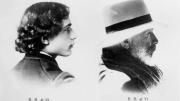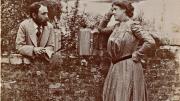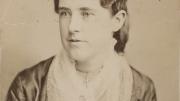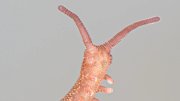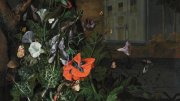in the fall of 1884, before Bernard Berenson (A.B. 1887) and Mary (Smith) Costelloe Berenson became world-famous experts on late medieval and Italian Renaissance art, amassing a vast collection they donated to Harvard (along with their Italian villa), they were a pair of eager college students with scant knowledge of the art world.
Mary was the privileged, eldest daughter of wealthy and established Philadelphia Quakers with a passion for literature. Bernard was the child of Jewish Lithuanian immigrants—his father worked as a tin peddler—hoping to further his religious studies. “He had been pointed out to me at one of the University concerts, as the most brilliant member of the then sophomore class,” Mary recalled in the draft for her biography of Bernard, but they did not formally meet—and fall in love—until their days at Harvard were over. Little has been written about their collegiate experiences until now.
Villa I Tatti, the Harvard Center for Italian Renaissance Studies, on the outskirts of Florence, is presenting a new online exhibition and electronic catalog, Berenson and Harvard: Bernard and Mary as Students, encompassing rare, unpublished material and information on the Berensons’ Harvard years. Gathered from Harvard libraries and archives—including the Biblioteca Berenson of Villa I Tatti, Houghton Library, the Harvard University Archives, and the Schlesinger Library of the Radcliffe Institute—the exhibit features early portraits and photographs of the Berensons, early writings, grade sheets, and 11 essays by modern scholars. (The finding aids for the Bernard and Mary Berenson Papers and the Berenson Family Papers, also online, provide even more detailed information on their time at Harvard.)
Berenson scholar Rachel Cohen’s essay, “Bernard Berenson at Harvard College,” offers a vivid portrayal of how Bernard’s views on religion, women, art, and money began to change in ways that would influence him throughout his career. “All his life, Bernard Berenson was a person whose capacity for metamorphosis approached that of the moth,” writes Cohen.
Berenson’s transformations were always accomplished at the cost of great struggle, especially over writing. Periods of grave self-doubt and self-recrimination were hidden below an ever-glossier surface. The outcome of the struggle—the new project or self-definition—almost always resulted in a deeper involvement with the study or sale of Italian pictures. Again and again, Berenson’s personal transformations would coincide with changes in the trade with which his life was so deeply entwined.
The exhibit features Bernard’s literary debut as a writer for the Harvard Monthly, including several essays (“How Matthew Arnold Impressed Me”), reviews (of Hermann Lotze’s Outlines of Aesthetics), poems (“The Mood of an Autumn Day”), short stories (“The Third Category”), and unsigned editorials (“Russian Literature”). “It is fair to presume,” he wrote in one of his editorials, “University Courses in English,” “that a great many students will have read the article on English in our colleges in the April number of Scribner’s Magazine, and the article will have been read with distinct complacency because the discussion of matters at Harvard College often precedes their discussion elsewhere; it is pleasant to be first in a discussion or a boat race.”
Jonathan K. Nelson, the exhibition’s curator, calls Berenson scholar Tiffany Johnston’s essay, “Mary Whitall Smith at the Harvard Annex,” an intellectual snapshot of Mary during “this pivotal moment in her development.” Although Mary had entered the Harvard Annex (Radcliffe’s first incarnation) as one of its first students, with the intention of pursuing medicine, she soon realized that no relevant courses were offered and began to take an interest in the visual arts, specifically in paintings. Regardless of their separate paths to art history, it was the Berensons’ studies at Harvard, Johnston notes, that “became the foundation of their life’s work together.”
Among the unpublished material is the first chapter of Mary’s “A Life of Bernard Berenson” (the most important source of information about the Harvard years of both students), Bernard’s detailed application for a Parker Fellowship to help prepare “for the position of a critic, or historian of literature,” and his senior thesis on “Talmudo-Rabbinical Eschatology.” (In an interview, Nelson noted a small but significant discovery made about Bernard by Nathaniel Hay ’14, a 20-year-old Harvard undergraduate intern at I Tatti: “Shortly before the exhibition opened, and during his first week as an intern, Nathaniel was hard at work transcribing an unsigned editorial about Russian Literature published in the Harvard Monthly in 1887, when Bernard was editor-in-chief. At the same time, Nathaniel was also transcribing Bernard's unpublished senior thesis. Our intern noted that a nearly identical line appears in both! This ‘smoking gun’ confirmed the attribution of the editorial to Bernard.”)
Though most of the Berenson's courses and readings touched only marginally on art history, says Nelson, “the university years of Bernard and Mary had a profound impact on their later scholarship.” In their later years, the Berensons specified that I Tatti should be a home for “mature students intending to be scholars in Art.”
In the preface to her 1933 book, A Modern Pilgrimage, Mary set forth their goal. The celebrated library of I Tatti would be “for future students, who, as we hope, will benefit from the ‘Institute for Humanistic Studies’ which we mean to found under the auspices of our common university, Harvard.”
